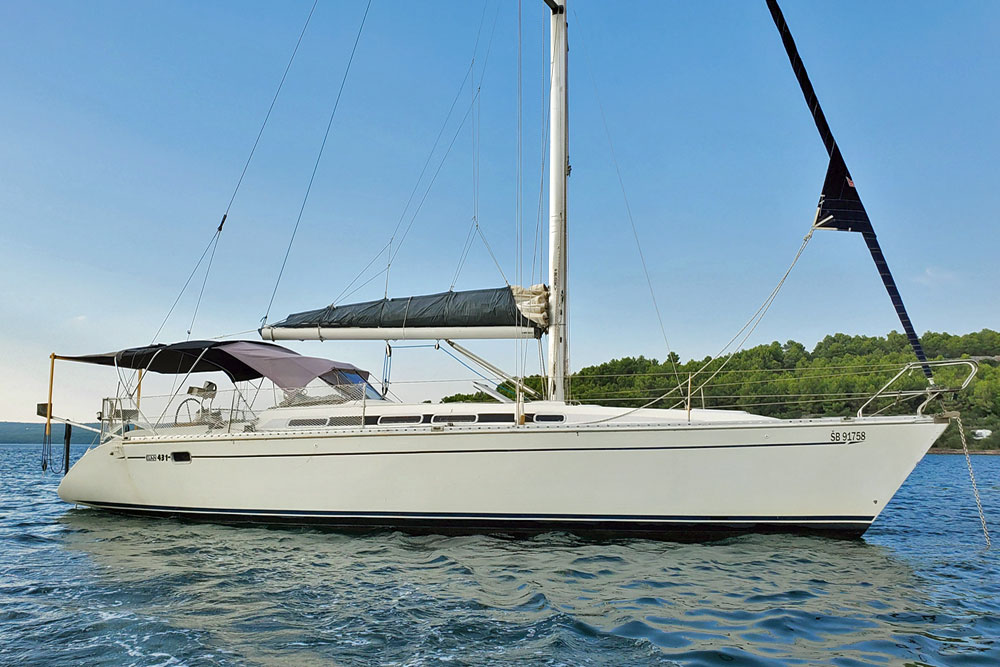- Home
- Cruising Yachts 40' to 45'
- Elan 431 Sailboat
The Elan 431 Sailboat
Specs & Key Performance Indicators
The Elan 431 sailboat, a light-displacement masthead sloop, was designed by the Slovenian design team J&J Design, and was constructed by Elan Yachts, a boatbuilding company located in the picturesque town of Begunje na Gorenjskem, Slovenia.
 An Elan 431 at anchor
An Elan 431 at anchorThe Elan 431 was available in three alternative versions:
- A 4-cabin version intended for the charter market;
- A 3-cabin version intended for family cruising;
- A 2-cabin version intended comfortable living aboard for a smaller crew.
Published Specification for the Elan 431 Sailboat
Keel & Rudder Configuration: Fin keel and spade rudder
Hull Material: Fiberglass (GRP)
Length Overall: 13.20m (43'4")
Waterline Length: 10.50m (34'5")
Beam: 4.10m (13'5")
Draft: 2.00m (6'7")
Rig Type: Masthead sloop
Displacement: 9,000kg (19,841lb)
Ballast: 3,200kg (7,055lb)
Designer: J&J Design
Builder: Elan Yachts (Slovenia)
Year First Built: 1994
Year Last Built: 1999
Number Built: Approximately 60 units
Published Design Ratios for the Elan 431 Sailboat
The Key Performance Indicators (KPIs)
- Sail Area/Displacement Ratio - 19.3: This ratio indicates that the Elan 431 has reasonably good performance capability. It suggests that the sailboat has sufficient sail power relative to its weight, making it capable of decent speed and performance under sail. It is suitable for both leisurely coastal cruising and more spirited sailing.
- Ballast/Displacement Ratio - 32.9:* A Ballast/Displacement Ratio of 32.9 implies that the boat has a moderate level of stiffness. It's not as stiff as a boat with a ratio of 40 or more but should still provide reasonable stability in various wind conditions. However, this ratio doesn't account for the location of the ballast. If the ballast is positioned lower, such as in a bulb at the foot of the keel, it would enhance the boat's stiffness more significantly than if the ballast were distributed higher up.
- Displacement/Length Ratio - 150: With a Displacement/Length Ratio of 150, the Elan 431 is classified as a light displacement sailboat. This means it requires less sail area to reach its hull speed, translating into better acceleration and more agile handling. Light displacement boats are usually swift and capable of making quick maneuvers, which is advantageous for both racing and casual cruising.
- Comfort Ratio - 23.1**: The Comfort Ratio of 23.1 places the Elan 431 in the category of a coastal cruiser with moderate stability. This indicates that the boat may experience some motion in rolling and pitching but should generally provide a reasonably comfortable ride for most sailors. It is suitable for coastal cruising but may be less comfortable in heavier seas compared to bluewater cruisers.
- Capsize Screening Formula - 2.0: A Capsize Screening Formula of 2.0 suggests that the Elan 431 is on the threshold for bluewater capability. It indicates that the sailboat has a reasonable beam-to-displacement balance, making it marginally acceptable for ocean passages but more suited for coastal cruising. Lower values are more desirable for extensive ocean voyages.
But, a few words of caution are appropriate...
- Ballast/Displacement Ratio*: This ratio's limitation is evident as it does not consider the exact placement of the ballast. The same ratio can imply different levels of stiffness depending on whether the ballast is in a shallow draft keel or concentrated in a deeper bulb keel.
- Comfort Ratio**: This measure is based on traditional heavy displacement designs with narrow beams and long overhangs. Modern light-displacement, beamy cruisers with plumb bows may not score as well on this ratio despite potentially having substantial comfort and stability due to advancements in design and technology. The Comfort Ratio might thus undervalue newer designs in assessing motion comfort.
In summary, the Elan 431 appears to be a well-balanced sailboat offering a combination of decent performance, moderate stability, and sufficient comfort for coastal cruising with marginal bluewater capability. However, understanding these ratios' theoretical nature and limitations ensures a more nuanced interpretation of the boat's capabilities, particularly with respect to ballast positioning and modern design features.
Here's how to calculate the KPIs yourself - without having to wrestle with the mathematics...
This article was written with the assistance of Gemini, a large language model developed by Google. Gemini was used to gather information, summarize research findings, and provide suggestions for the content and structure of the article.
Recent Articles
-
Which Type of Boat Fridge Is The Most Efficient?
Apr 24, 25 05:06 AM
The top opening boat fridge is reputed to be more efficient than the front opening type, but that may not be the case - and here, amongst other boat refrigeration considerations, is why -
Multihull Autopilot Selection is Not Straightforward
Apr 19, 25 01:25 PM
Whether its for a catamaran or a trimaran, tiller or wheel steered, a multi hull autopilot must be endowed with specific performance characteristics... -
Wheel-Steering Autopilots: Your Questions Answered...
Apr 18, 25 03:45 PM
Whatever your question, you should find the answer here












